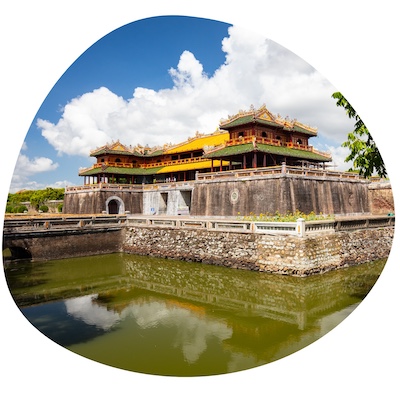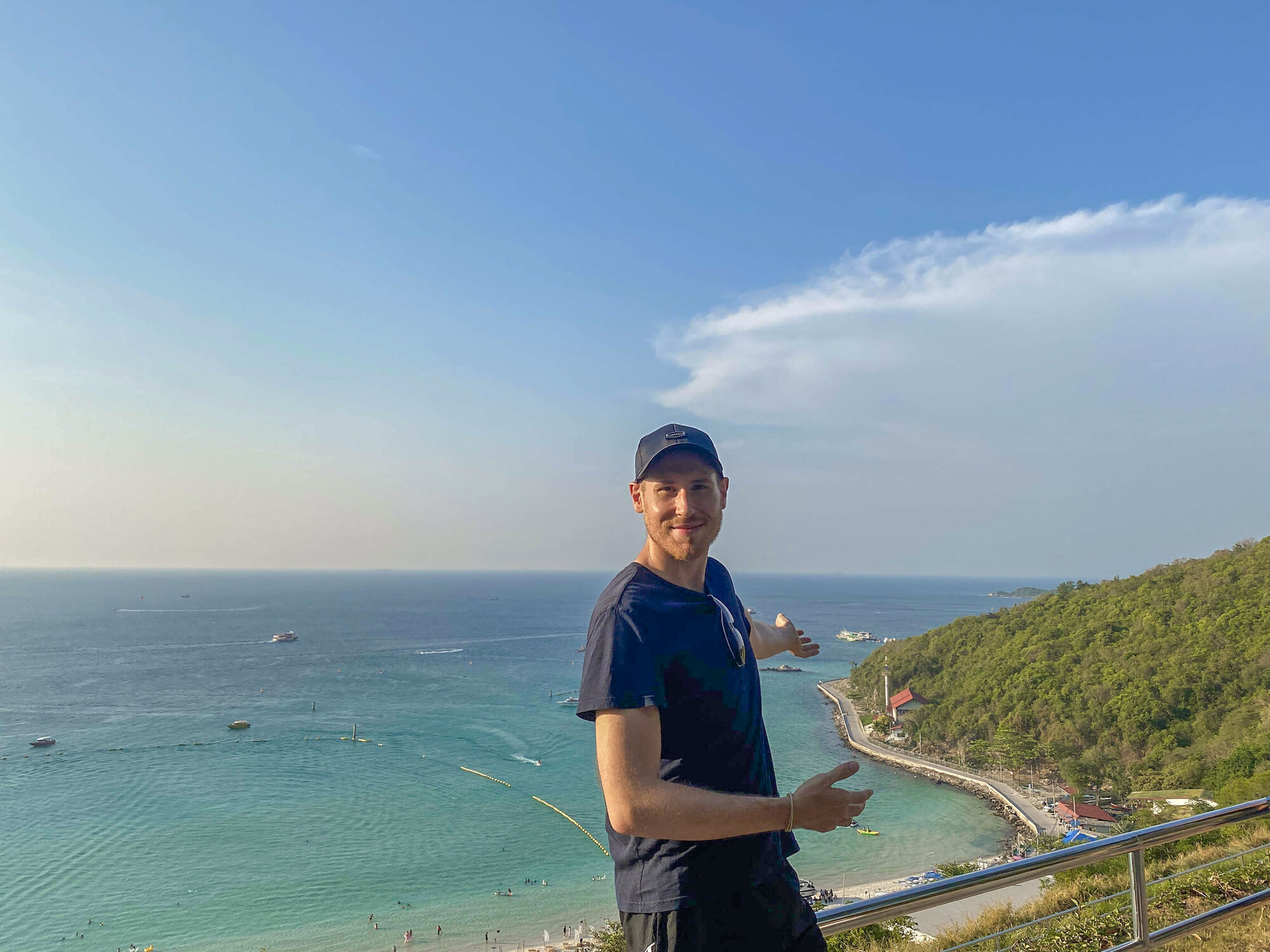Ready for a journey back in time with a side of delicious food? Planning one day in Hue itinerary promises just that and more.
Nestled in the heart of Vietnam, Hue is a treasure trove of history, home to the majestic Imperial City and the tranquil Perfume River.
Yes, most tourists choose Da Nang and Hoi An over a Hue day trip, but I personally recommend adding it to your trip.
In Hue, every corner has a story, every meal is a discovery, and you won’t find as many crowds as you would in other parts of Vietnam. Ready? Here’s everything you should know for spending a day in Hue!
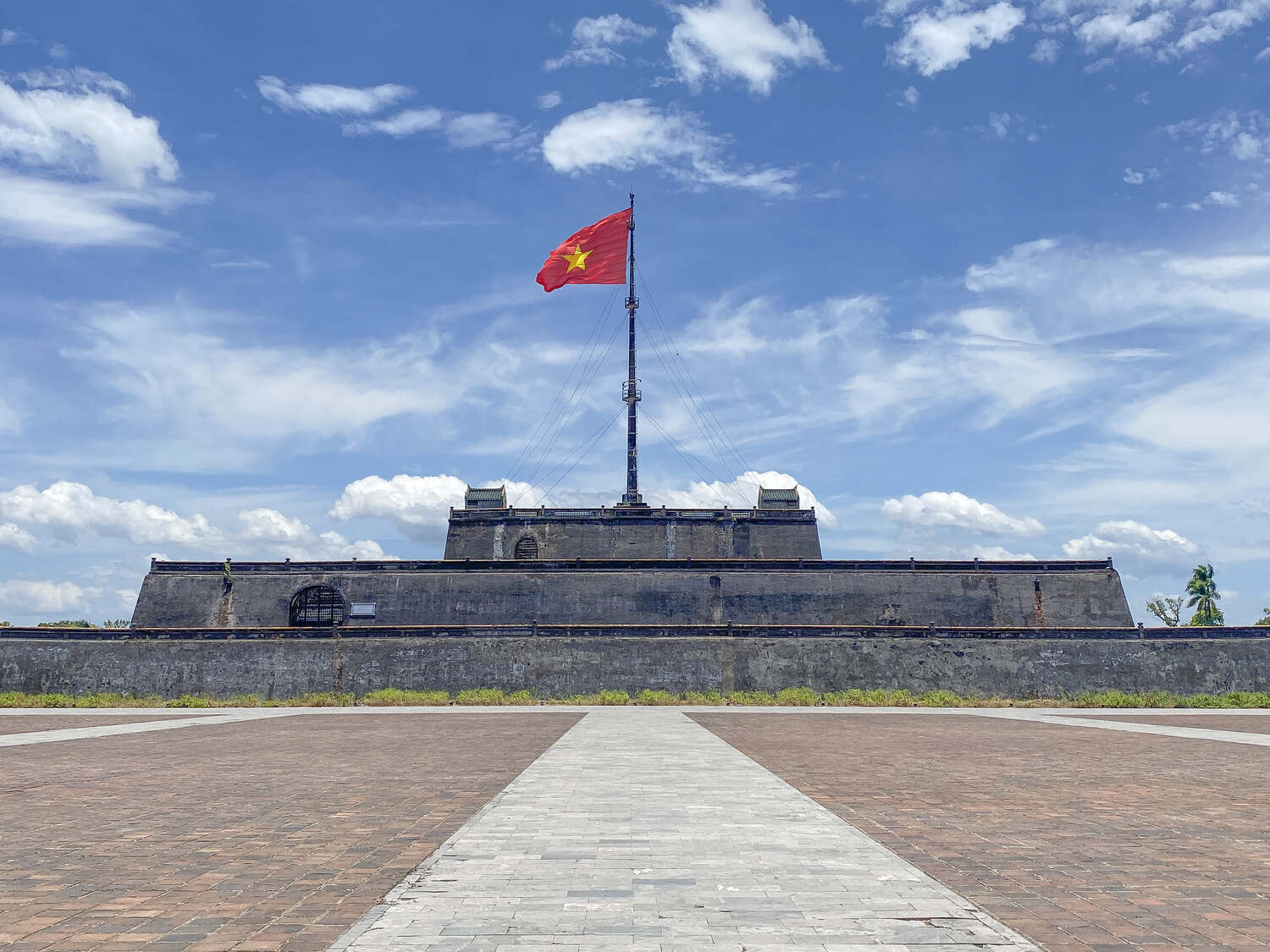
Table of Contents ⬇️
ToggleOne Day in Hue Itinerary – Summary
This section is all about helpful planning tips and advice on things like the location of Hue, how to get there, what time should you travel, and much more.
Where is Hue?
Hue is in the central part of Vietnam and has rich historical and architectural places. It was the seat of the Emperor of Vietnam, the capital of Vietnam during the Nguyen Dynasty (from 1802 to 1945).
Located on the bank of the Song Huong (Perfume River), Hue is some 90 kilometers from Da Nang, and 120 km from Hoi An Old Town.
How to Get to Hue?
When it comes to transportation, finding your way to Hue is pretty straightforward. Hue is connected by train and the Reunification Express, with beautiful views of the coast if you’re traveling from Hanoi or Ho Chi Minh City.
Another suggestion would be to rent a scooter in either Hoi An or Da Nang if you have some experience driving or you are ready for an adventure. If this is your first time, please do not ride around in Vietnam, considering at one point, you will pass the Hai Van Pass.
Lastly, you can join a day tour from Da Nang or Hoi An to Hue, which isn’t only convenient but also affordable and includes everything you need, from transportation to the entrance fees and lunch.
Best-Rated Tour
How to Get Around Hue?
The best way to see Hue for short distances is by walking since it is a small city. Bicycles and motorbikes can also be rented to make your trip more convenient (if you haven’t already rented one in Da Nang).
For comfort, taxis and ride-hailing services like Grab are readily available.
Additionally, you can ride a cyclo, another special way of exploring around Hue. Cyclos are three-wheel bikes, so people can ride and listen to the tour guide explaining everything about the city and the local landmarks.
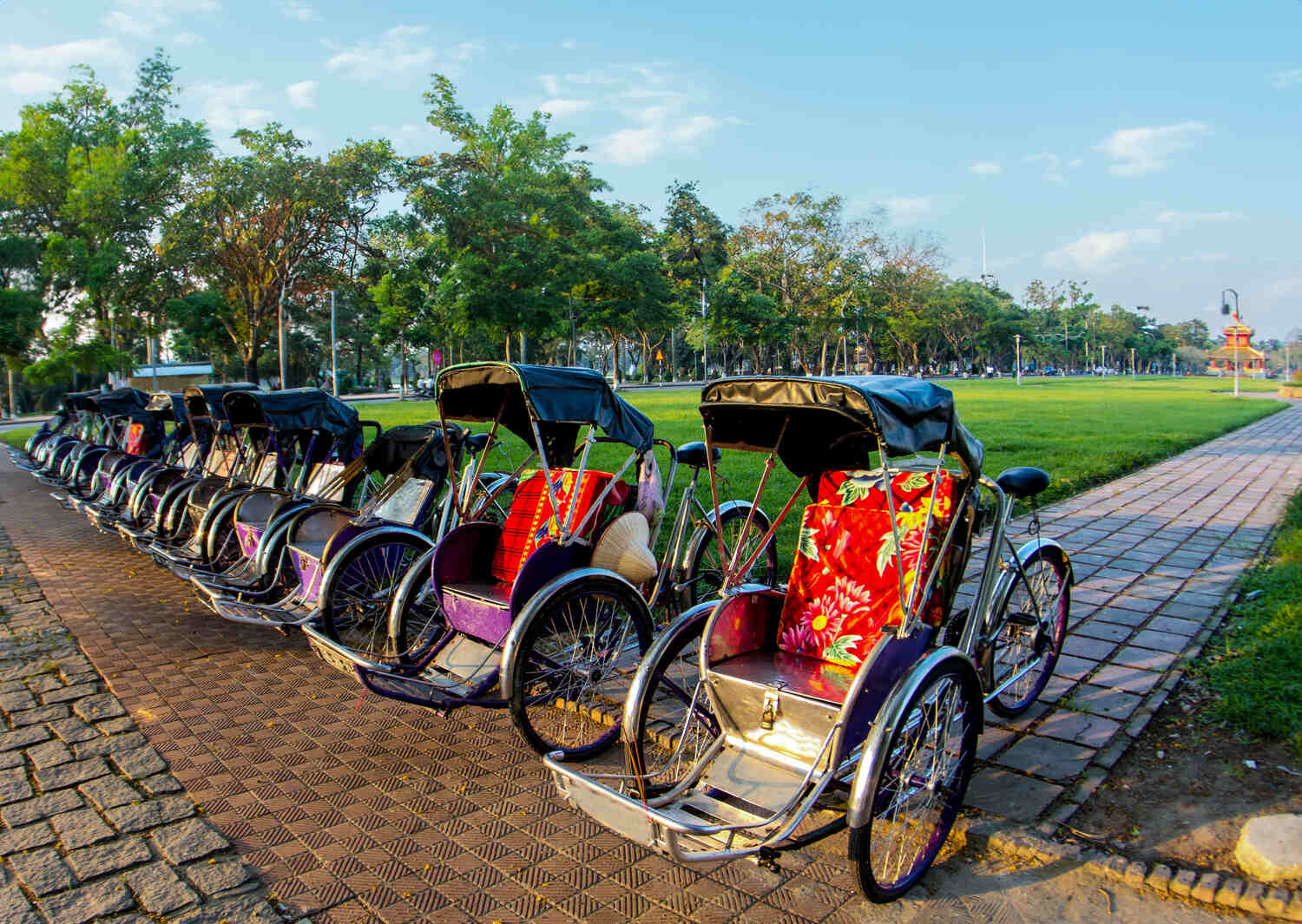
How Many Days in Hue City?
Taking a Hue day trip is enough to scratch the surface and see the key historical sites, and pagodas, and try delicious food.
Alternatively, if you have more time when traveling in Central Vietnam, why not extend your time and stay 2 days in Hue?
This allows ample time to explore the Imperial City, the tombs of Nguyen emperors, and Thien Mu Pagoda, with leisure to enjoy a boat ride on the Perfume River.
The Hue Monuments Ticket
Hue has a monuments ticket, which I recommend getting if you do not join a guided tour from Hoi An or Da Nang.
Essentially, this ticket allows you to get into the main tourist attractions, which are the Imperial City and all the Mausoleums. The price depends on the places you plan to visit, starting from the Hue Royal Palace only for US$8.99 to all the sites for US$22.45.
Overall, this is the same price as buying it on the spot and you’ll get to some yourself some headache and waiting times in lines.
For the Imperial Fortress only, it’s the “Hue Royal Palace Admission Ticket” while you can get the “Combo 4 sites” for all places and all the royal tombs if you have more time available in Hue.
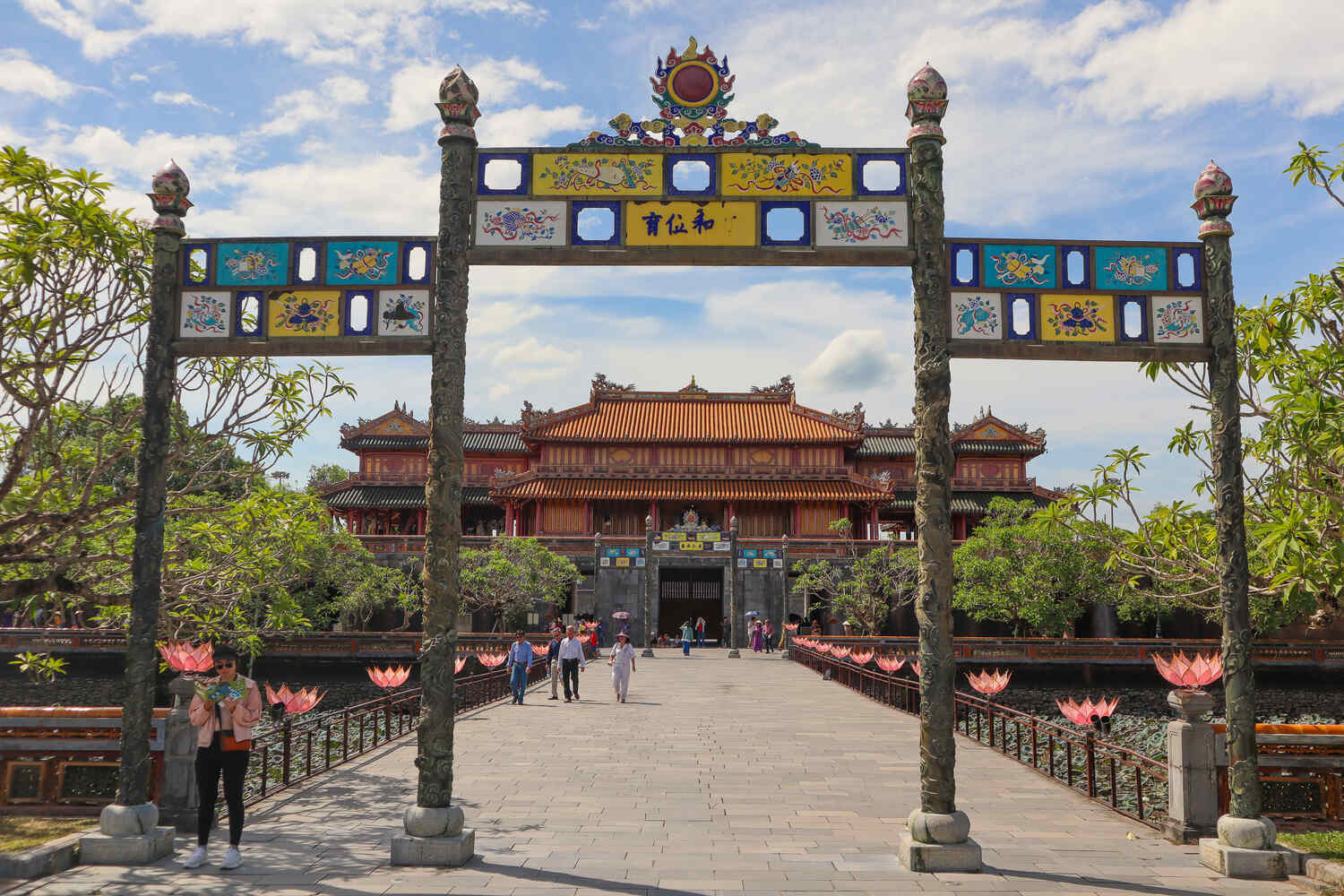
Ultimate Day Trip to Hue Itinerary
Now that you have a little more context and information for your day trip to Hue, let’s go through this itinerary that I’m sure you’ll love.
Note that it does seem packed, but you won’t feel too rushed, despite having only 24 hours in Hue.
Morning: Hue Imperial City
Hue Citadel, the historical centerpiece in town, was the political, cultural, and religious hub of Vietnam during the Nguyen Dynasty’s rule from 1802 to 1945. And being the most popular tourist attraction in Hue, Vietnam, that’s where you should start the day.
Enclosed by massive stone walls and surrounded by a moat, the complex is a sprawling citadel filled with palaces, historic buildings, temples, and museums.
Located in the heart of Hue, it’s a UNESCO World Heritage Site that offers a window into the grandeur of Vietnam’s royal past.
Highlights inside include the Forbidden Purple City, once exclusive to the emperor and his entourage. You can spend hours exploring the intricate architecture and vibrant history of this royal enclosure – I recommend planning at least 3 hours, as the complex is massive.
Also, there’s a VR station inside where you can sit and see how the former Imperial Capital looked in its best days, and you don’t want to miss that.
The Hue Citadel is open from 7.30 AM to 5.00 PM, and the entrance fee is 200,000 VND per person, which is about US$8, and it’s included in the monuments ticket I shared above.
Alternatively, if you want to know all the history and fun facts of the site, considering joining a walking tour of the Imperial Citadel, which is pretty cheap and you’ll learn everything about it, which is excellent.
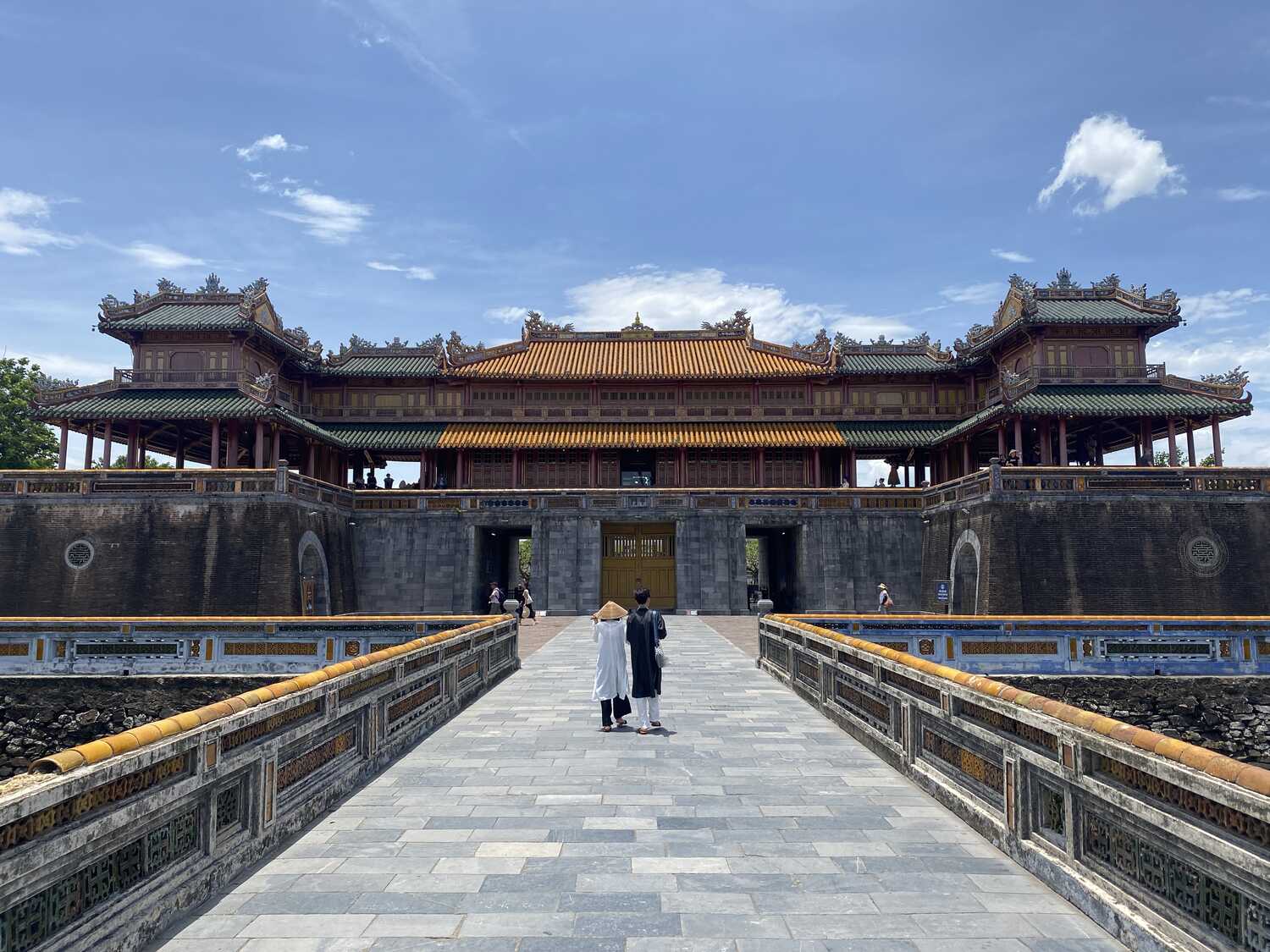
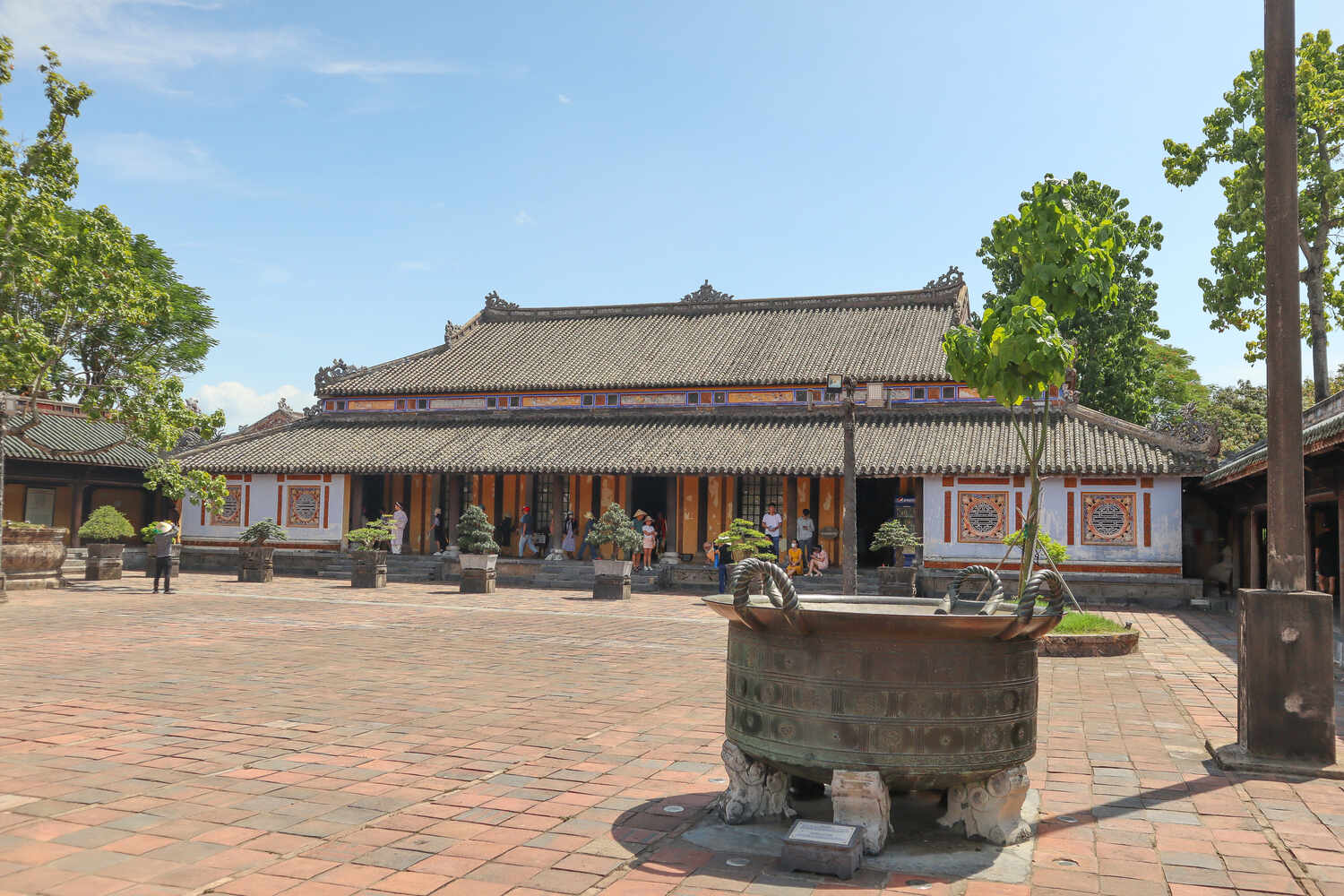
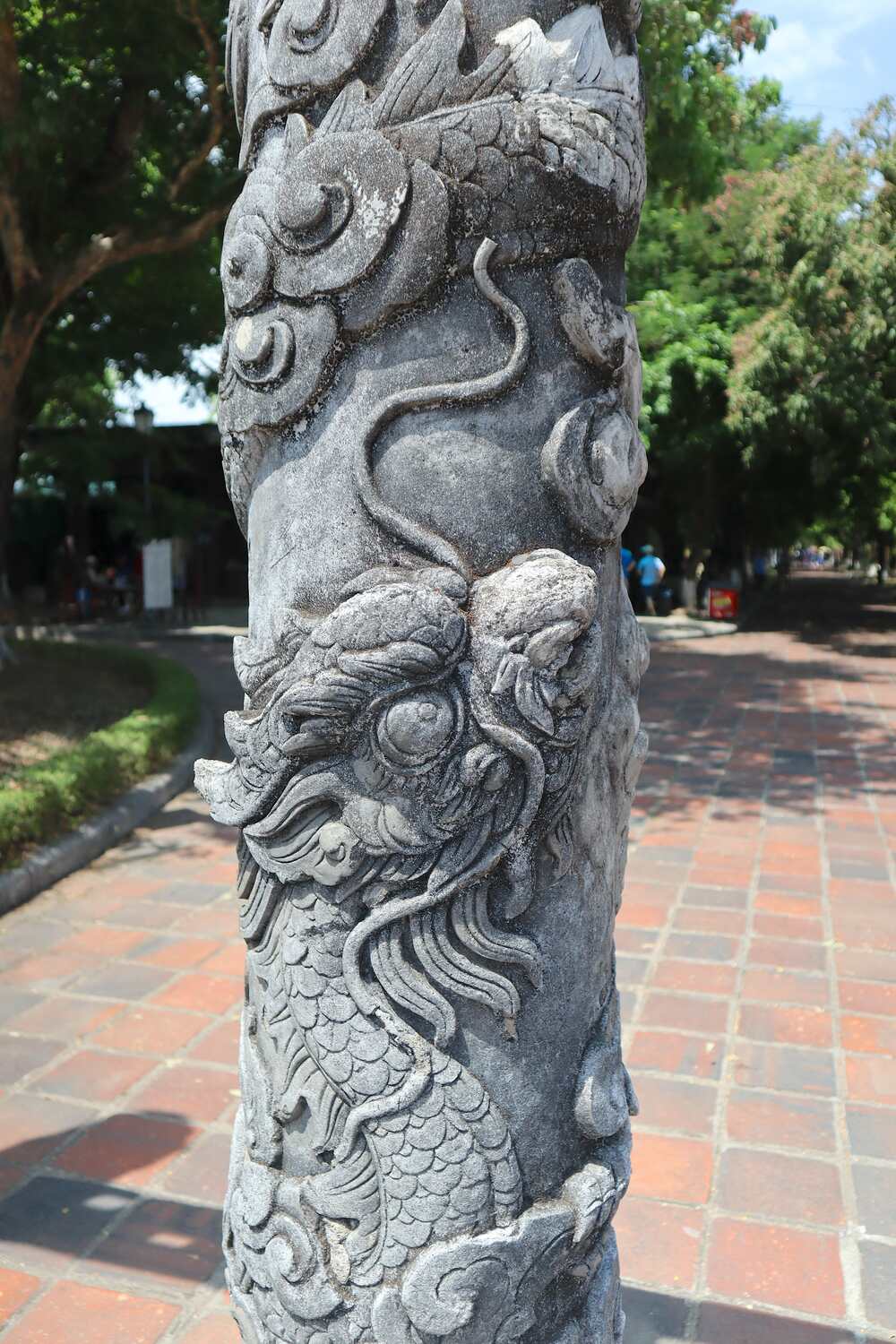
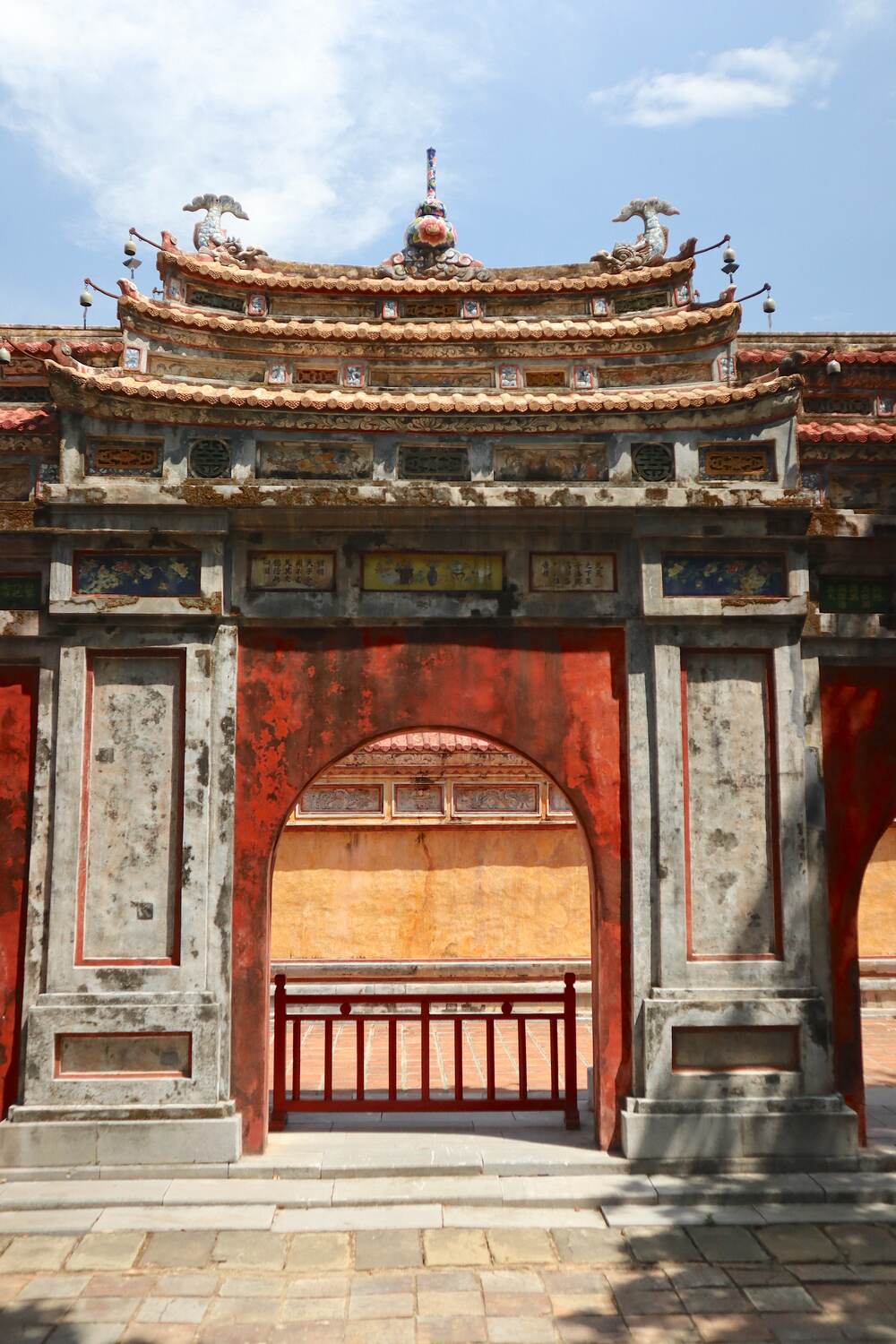
Morning: Thien Mu Pagoda
The next destination is the Thien Mu Pagoda (which is a must-see when you’re in Central Vietnam) and it’s located along the Perfume River which allows for beautiful views and a peaceful feel.
The Thien Mu is a seven-story Pagoda that was built in 1601, serving as a symbol of the city and is visible from many parts of Hue.
Today, the grounds host a complex of buildings such as temples, gardens, and shrines. Of special note, the car of Thich Quang Duc is on display, a monk who immolated himself in 1963 to protest the South Vietnamese government.
Thien Mu Pagoda is not only a religious place, it is also a peaceful spot where you have a panoramic view of the river and far beyond, a spot to get away if you are looking for some comfort!
Best of all, there’s no entrance fee, which is great! If you have more time available, consider taking a dragon boat trip along the Perfume River, which is a nice way to see Hue.
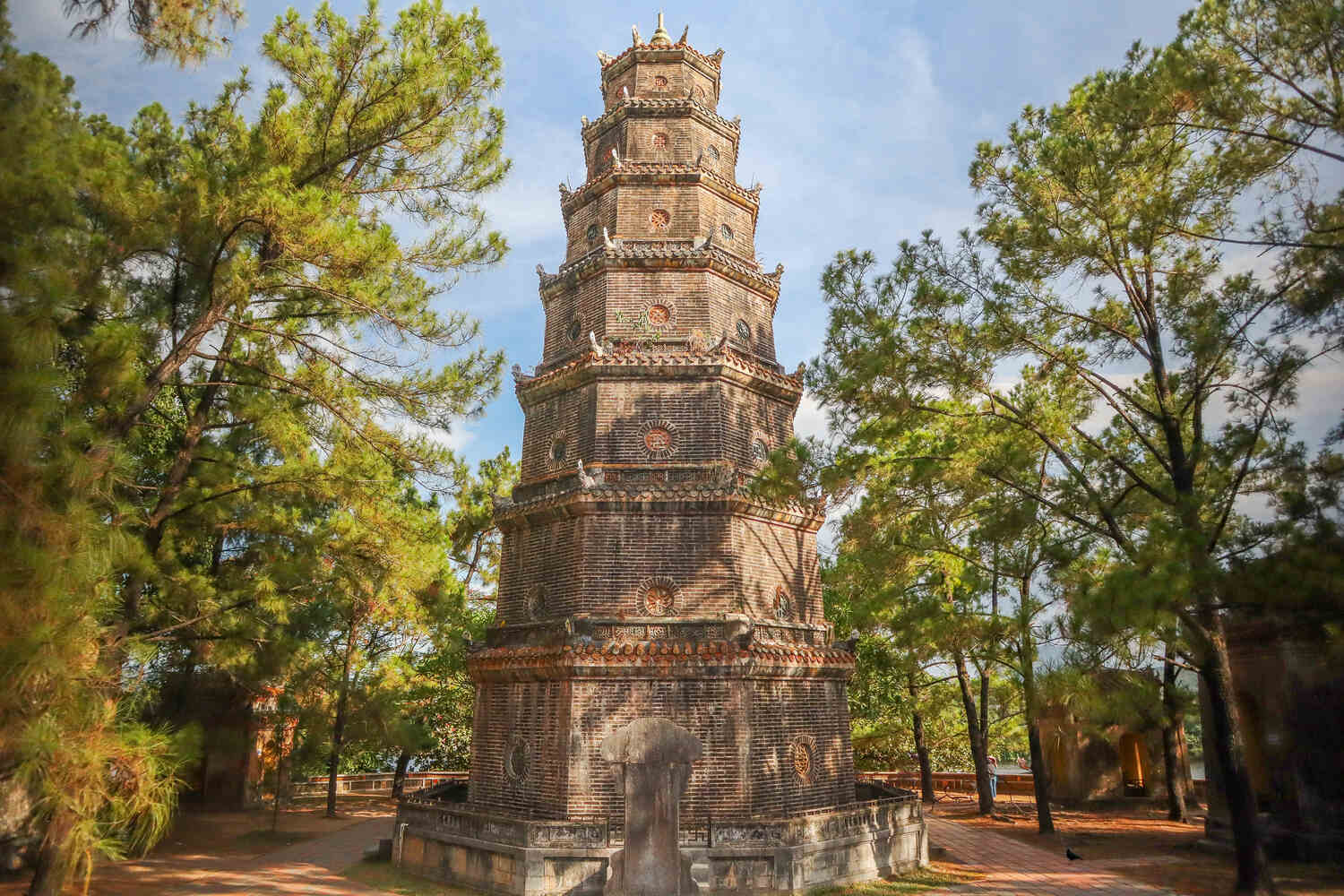
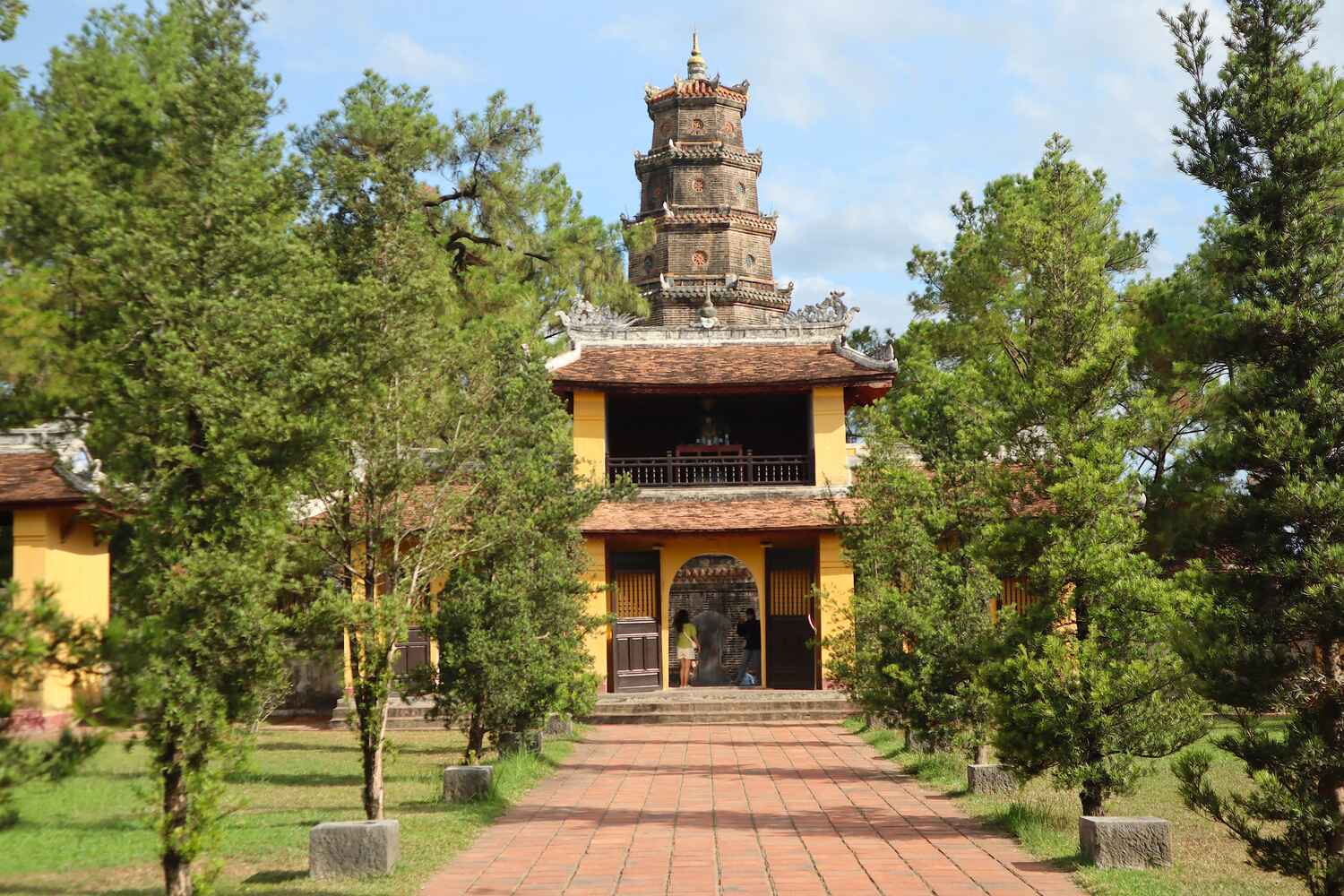
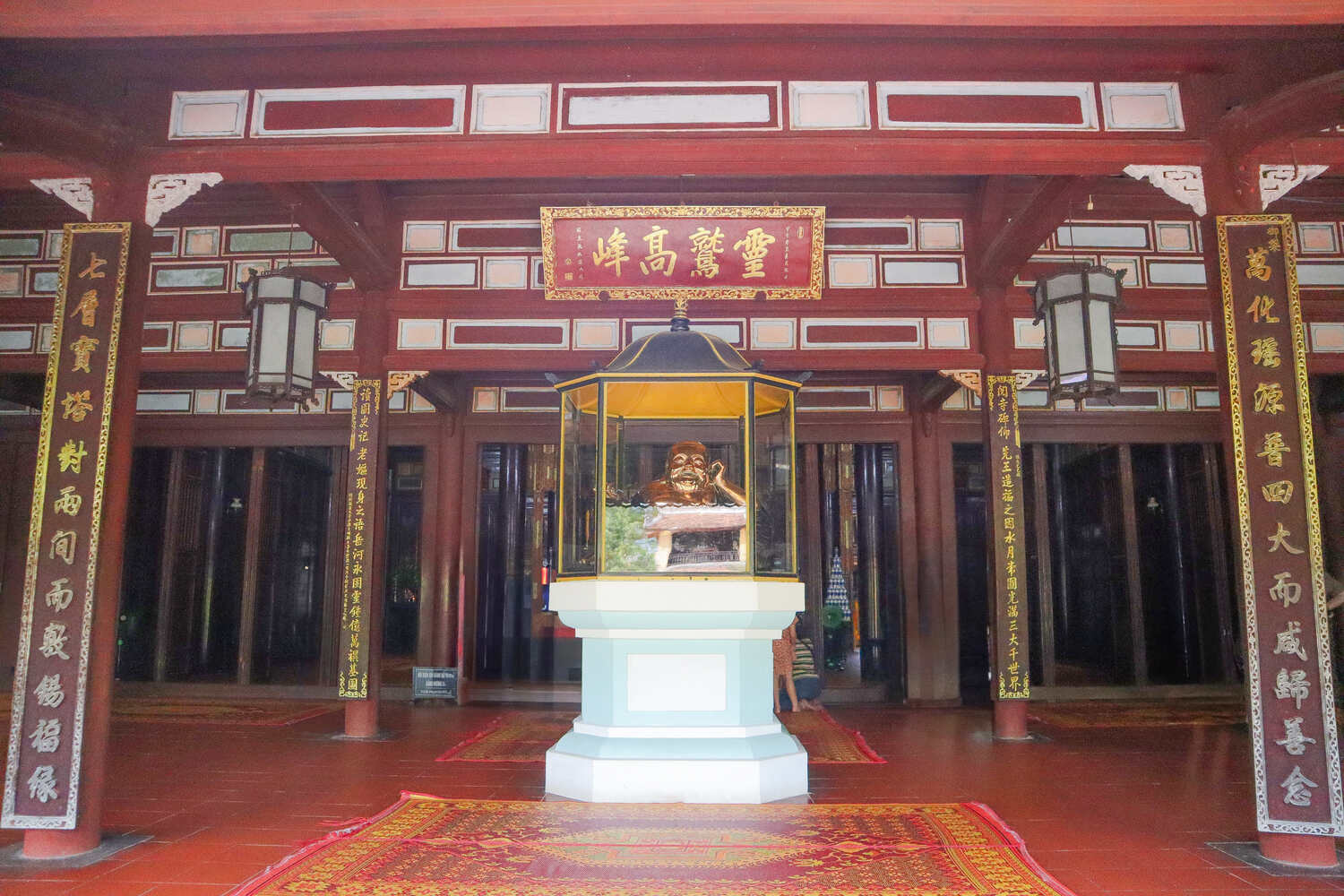
Lunch at Nook Eatery
When your stomach starts rumbling after exploring Hue Imperial Citadel, Nook Eatery is the place to be. This is where I ate when I visited Hue, and loved the place.
It’s a cozy spot that feels like you’re eating in someone’s home rather than a restaurant, living the local life. They serve up some delicious Vietnamese dishes with a twist, and everything’s super tasty.
The vibe is relaxed, the food is fresh, and the coffee is strong. It’s the perfect midday stop to fuel up for the rest of your day’s adventures. Try their local specialties; you won’t be disappointed!
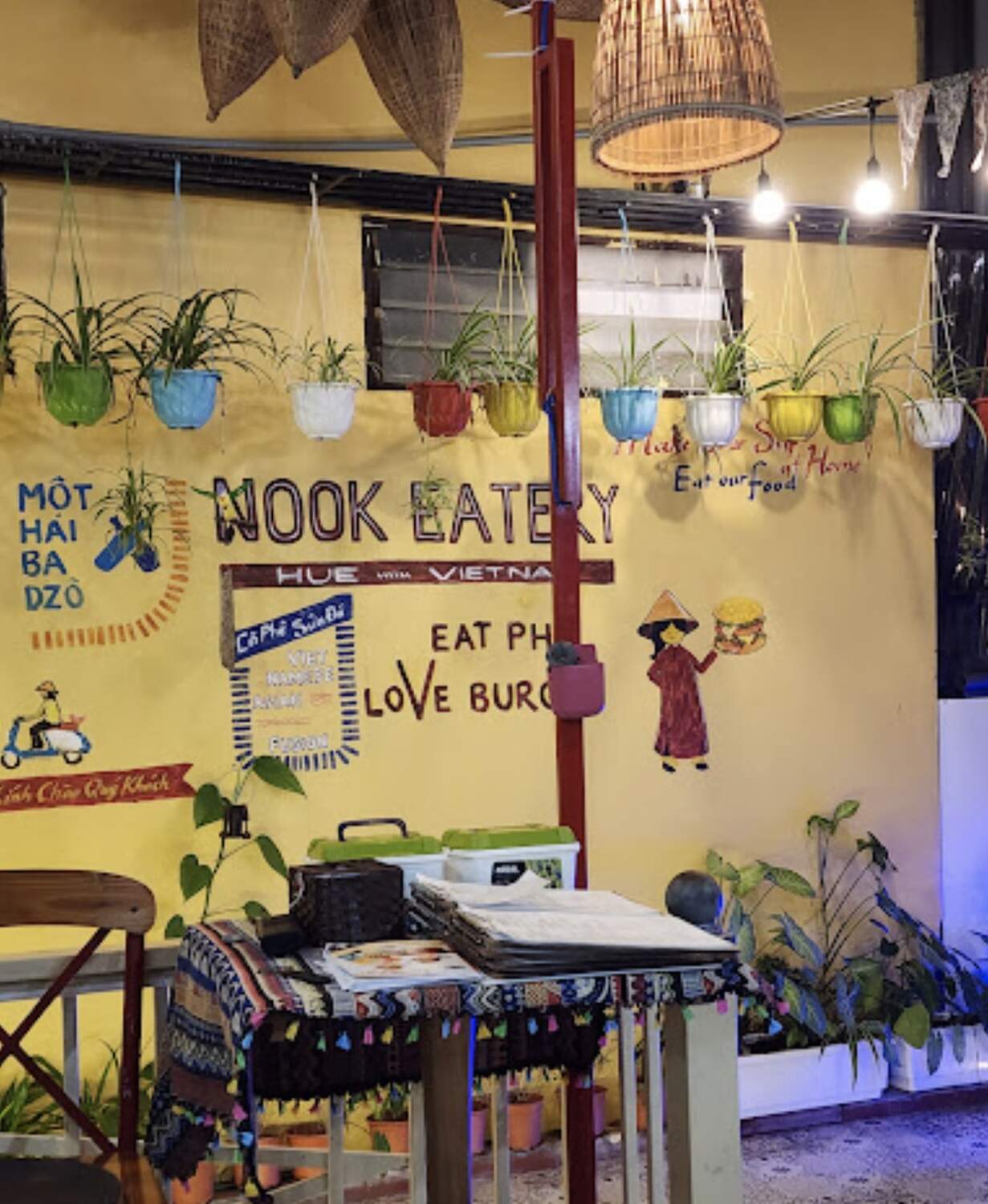
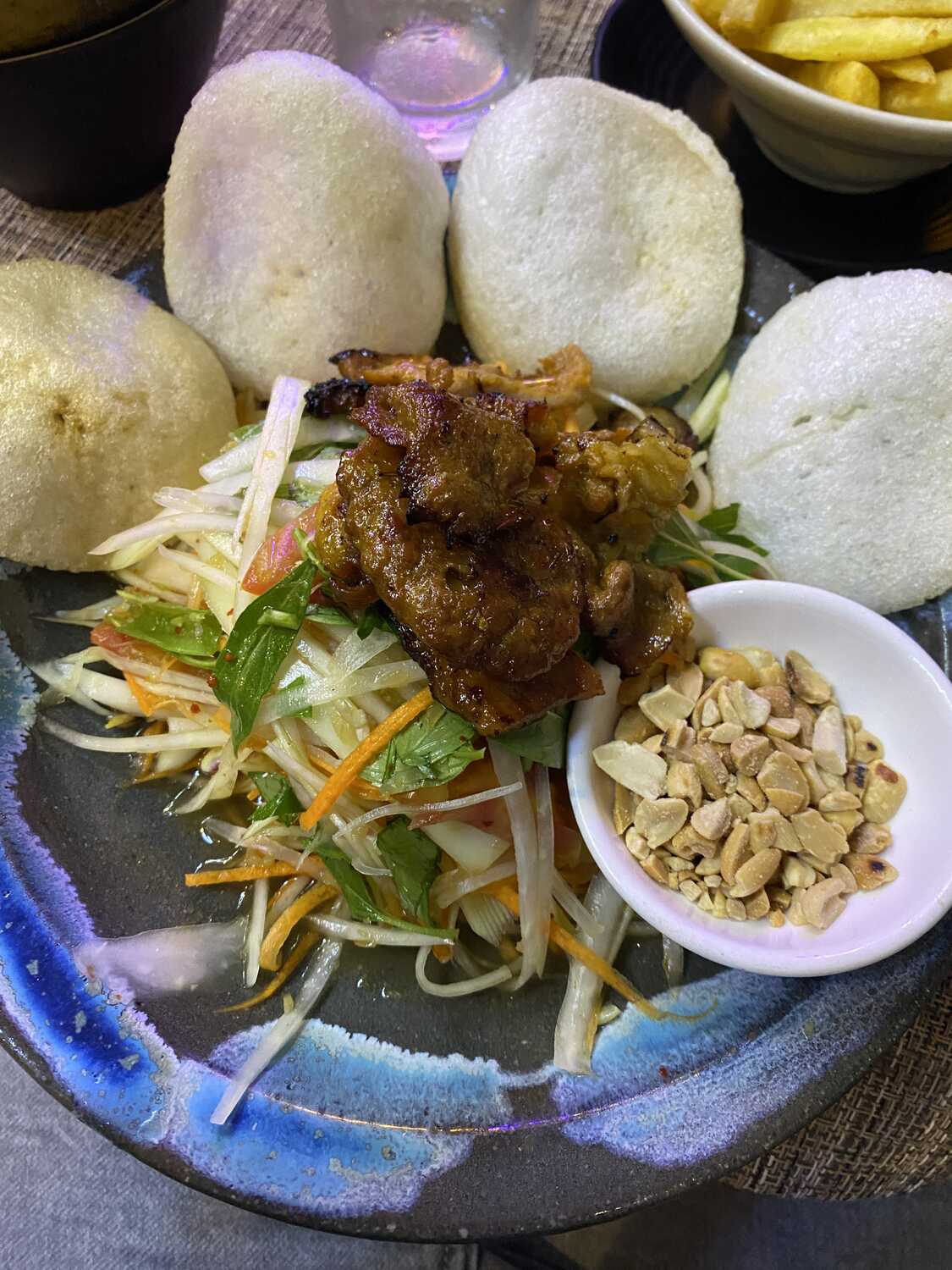
Afternoon: The Tomb of Khai Dinh
The Royal Tomb of Khai Dinh is the burial place of the 12th emperor of the Nguyen Dynasty in Chau Chu village, 10km from Hue. The site took a long time to build, eleven years from 1920-1931, and is a mixture of Western and Eastern architectural styles.
The tomb is a maze-like multi-level complex of courtyards, pavilions, and the main building that has a statue of the emperor and personally designed interiors. The main highlight of the tomb is the interior, which is decorated extensively with mosaic murals using colored broken ceramics and glasses.
A visit to the Emperor Khai Dinh Tomb is your chance to learn about Vietnamese colonial history and is also an excellent way to spend the afternoon in Hue.
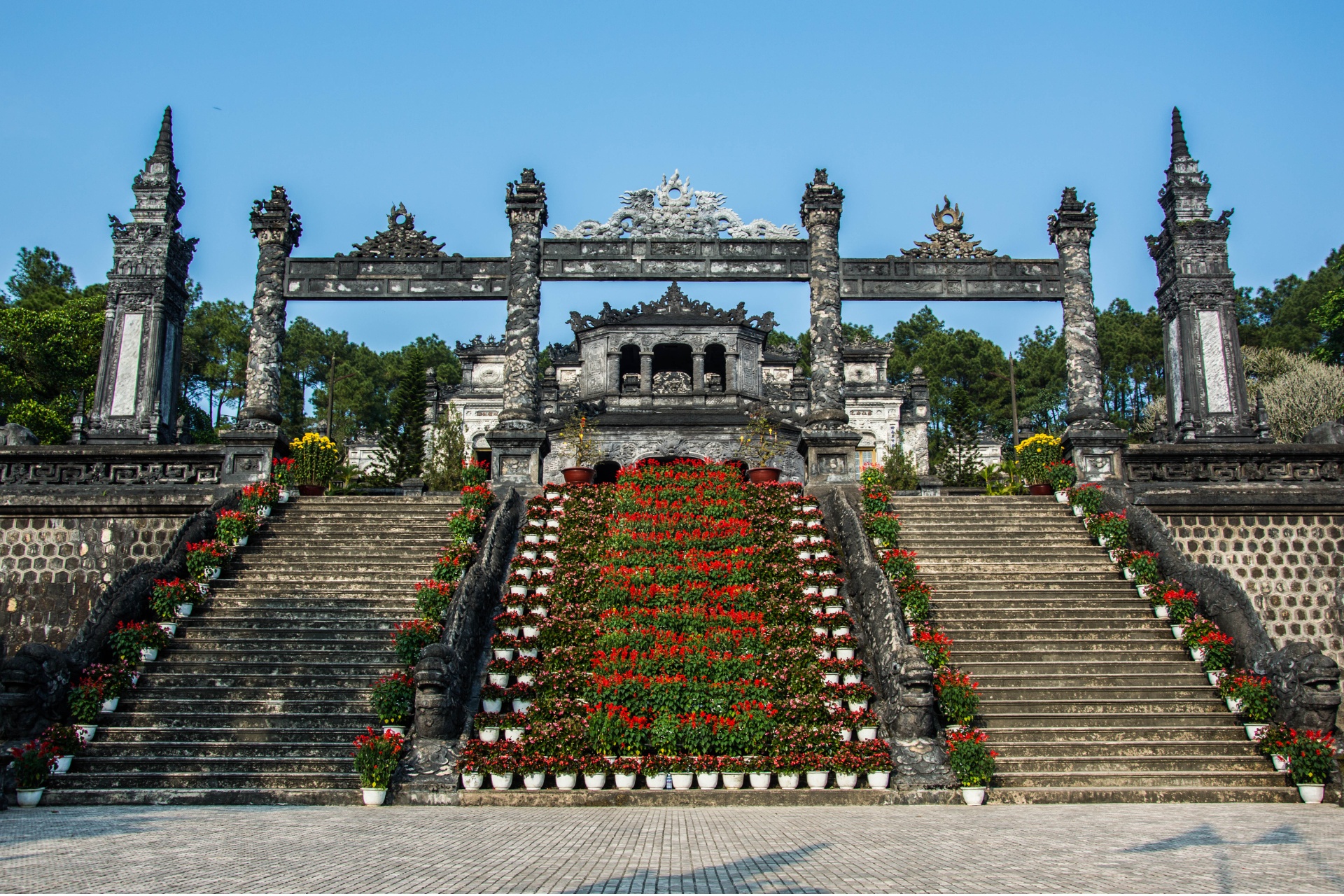
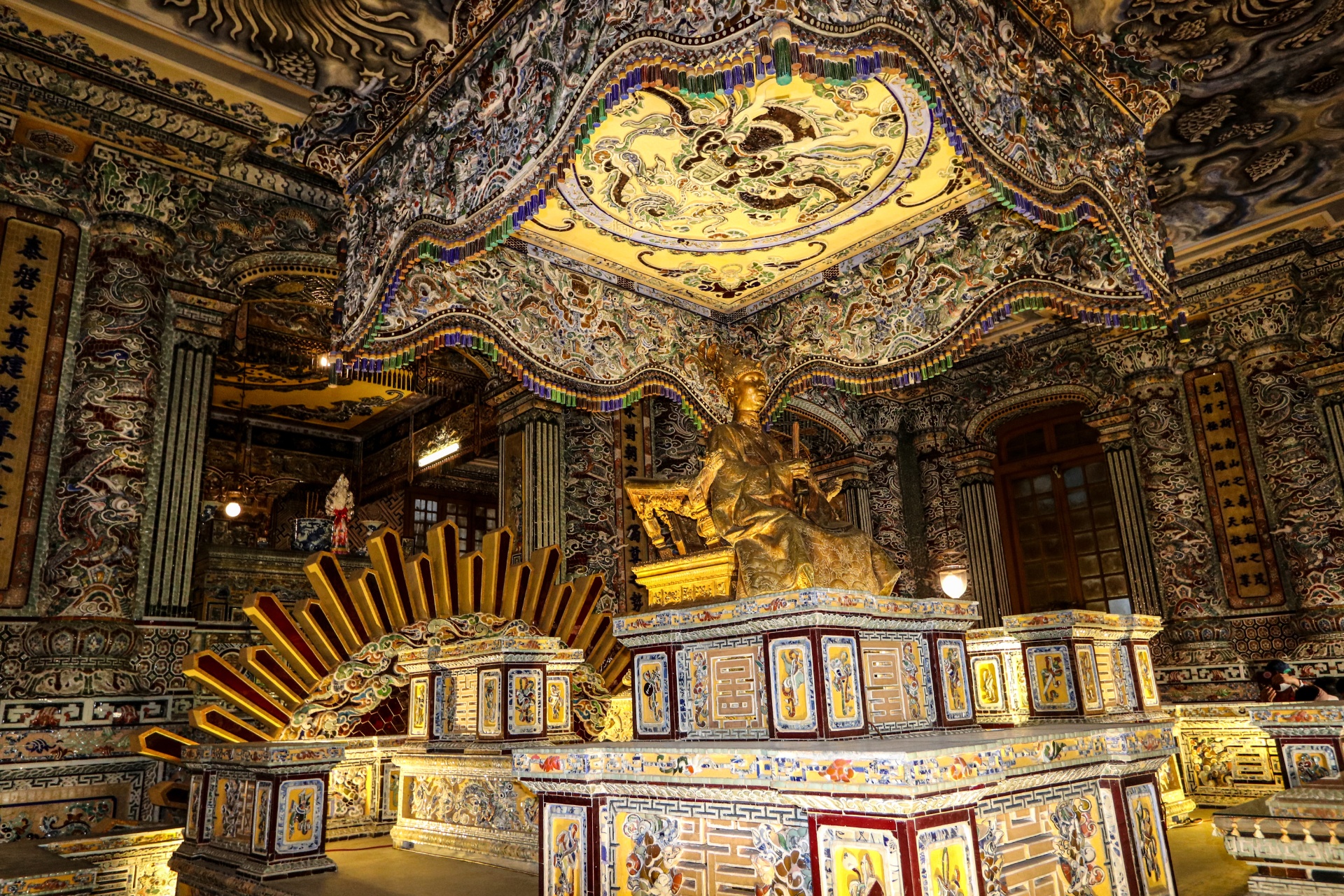
Sunset at TTC Imperial Hotel
Wrap up your day with sunset views at the TTC Imperial Hotel. Go to the rooftop bar for some fine views over town and the whole city, the river and mountains in the distance.
A great place for a cool drink with a view of the sky changing colors. The atmosphere is relaxed & would be a good place to reflect on the day spent in Hue.
Regardless of whether you are a guest of the hotel or not, make sure you go here before the day is over!
On the other hand, if you’re reading this on time, why not staying here for the night and making your stay one to remember? Check it out here below, they sell out very often.
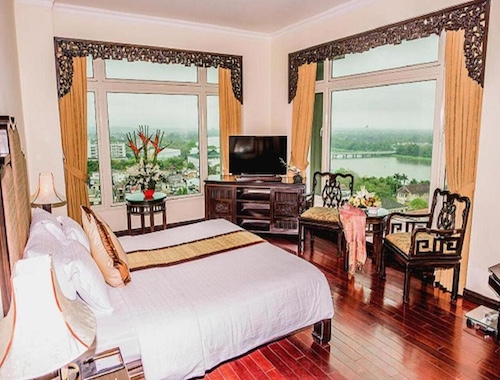
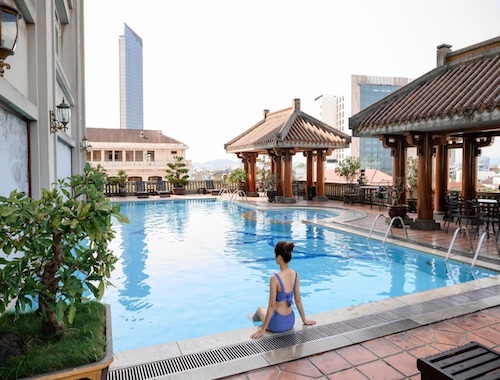
End the Day at Nguyen Dinh Chieu Walking Street
End your adventure in Hue by soaking in the vibrant atmosphere of the Hue Night Walking Street. As the sun sets, this bustling area comes alive, offering an eclectic mix of bars, restaurants, and street food vendors that capture the essence of Hue’s lively nightlife.
Whether you’re in the mood for a refreshing beer, a delicious meal, or just some light snacks, you’ll find plenty of options to satisfy your cravings.
The walking street is not only a foodie’s paradise but also a great place to experience the local culture, with live music performances and street artists adding to the festive vibe.
Note that it’s not a massive night market like those you might have seen in Ho Chi Minh City or Hanoi, but it’s still a nice place to end your trip to Hue.
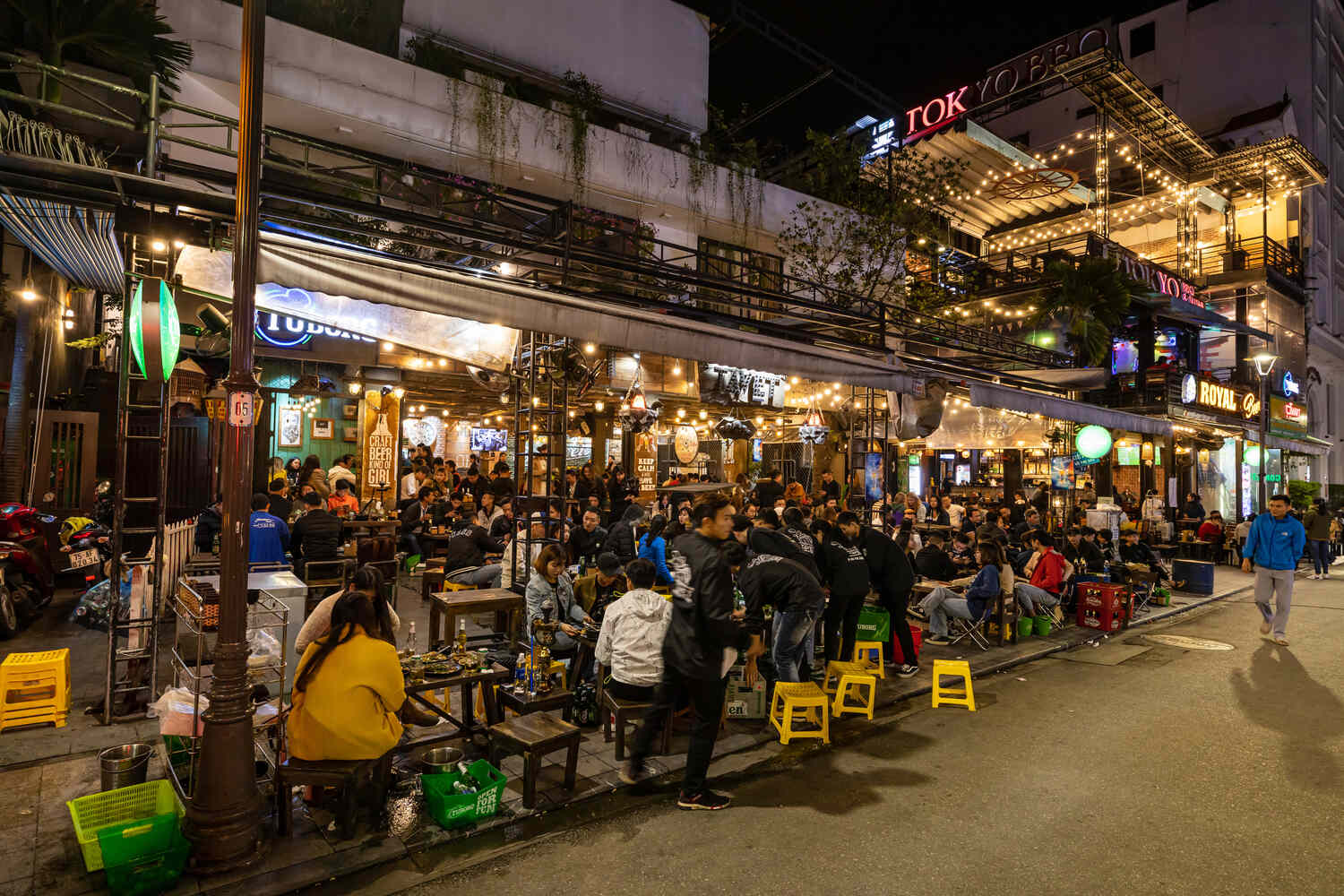
More Things to Do in Hue for a Day
In case you have more time available or want to skip one of the attractions I listed when visiting Hue, here are some other key spots in and around town you’ll want to check out to learn about Vietnam’s past Emperors.
Minh Mang Tomb
Emperor Minh Mang Tomb, located about 12 kilometers from Hue and just around 10 minutes from the Tomb of Khai Dinh, is the final resting place of the second Nguyen Dynasty emperor.
Set near lush forests and tranquil lakes, the tomb is a masterpiece of Vietnamese traditional architecture, blending harmoniously with its natural surroundings.
Designed during Minh Mang’s reign but completed after his death in 1841, the complex spans several hectares, featuring gardens, stone bridges, and serene lotus ponds.
You can easily spend 2 to 3 hours roaming around and discovering Minh Mang’s Tomb, and it’s overall a must-do if you’re interested in Vietnam’s history.
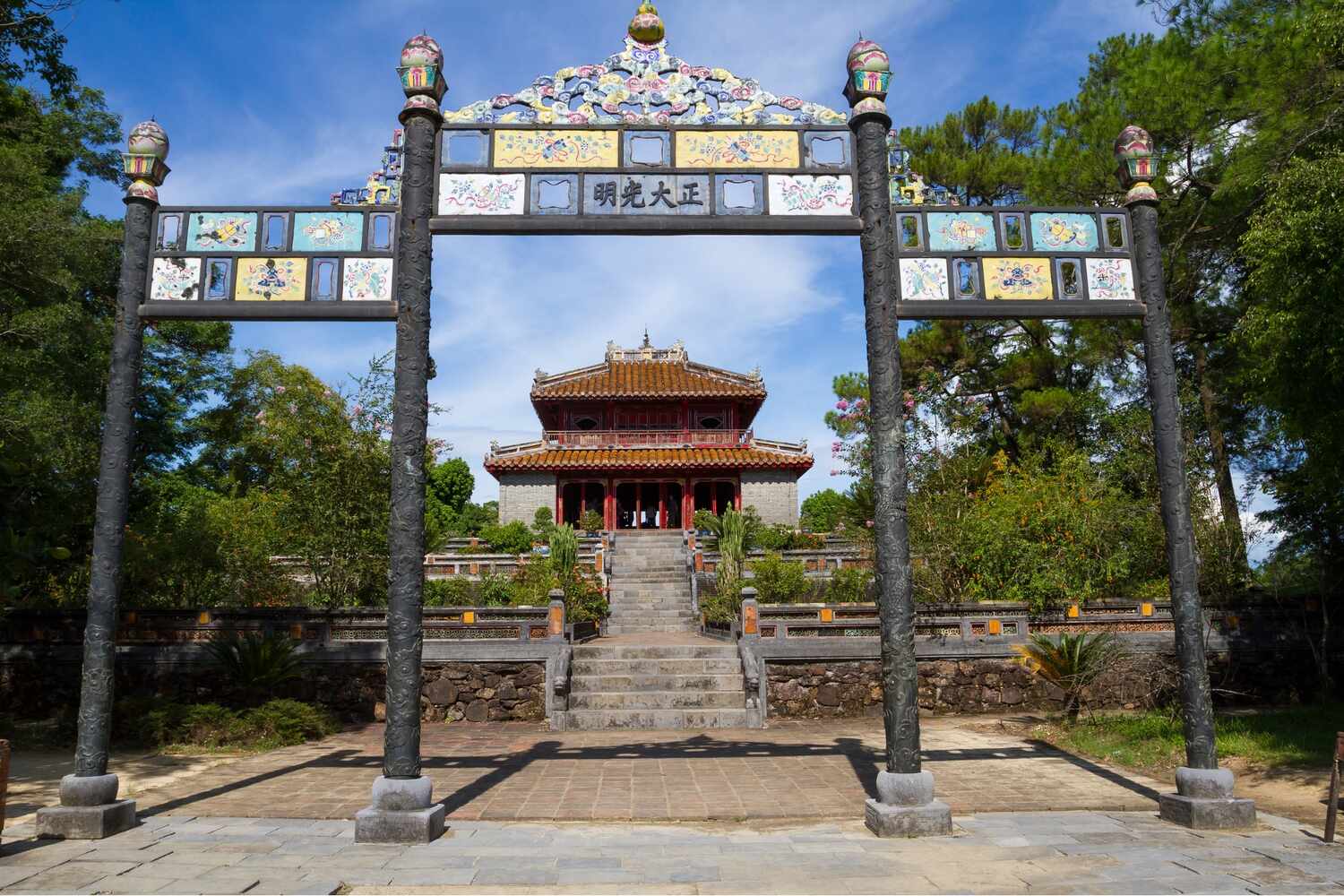
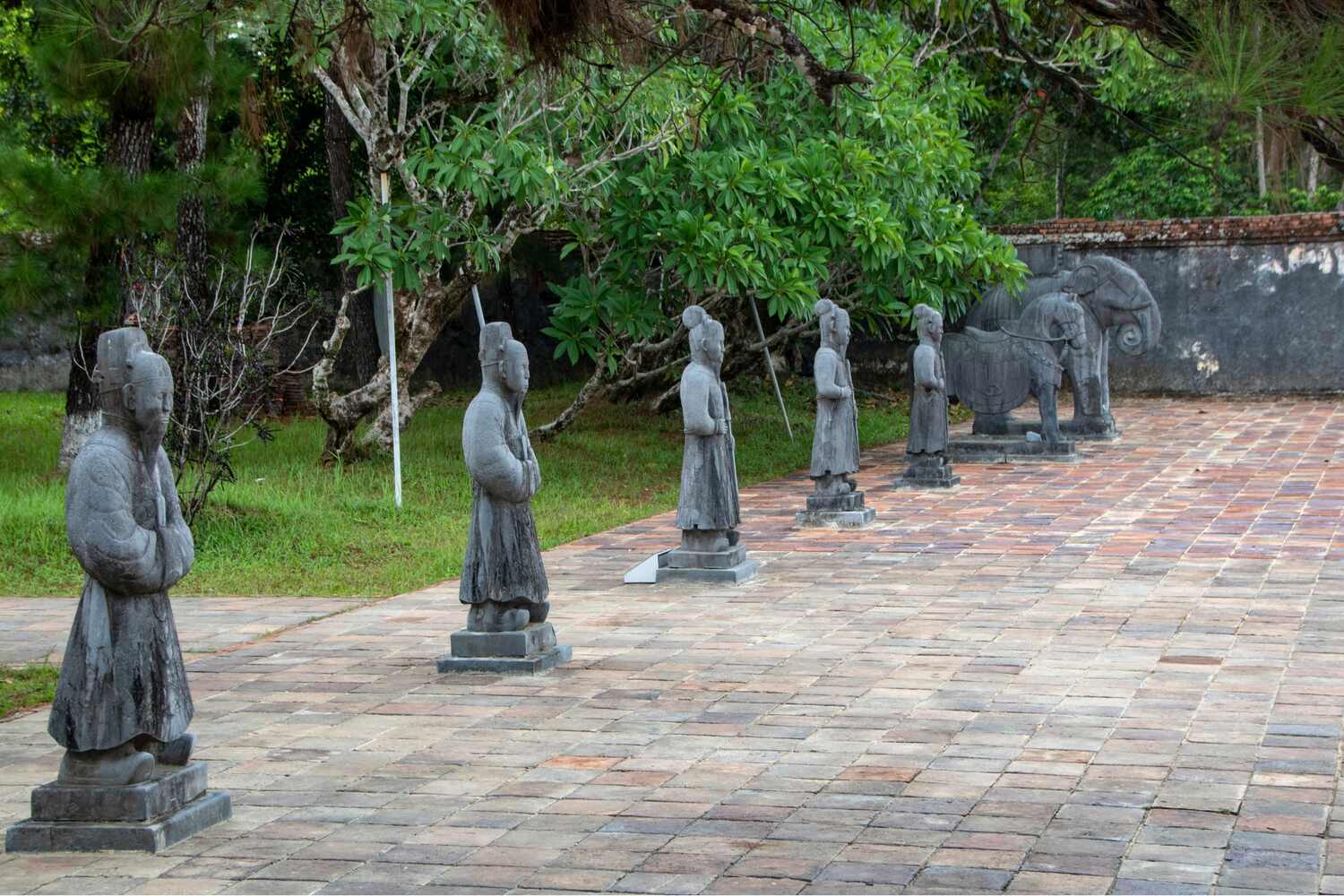
The Temple of Literature in Hue
The Temple of Literature in Hue, often associated with Hanoi’s more famous counterpart, serves as a symbol of scholarship and learning in Vietnam.
This Confucius temple is a symbol of Vietnam’s long tradition of education and scholarship. Located in the heart of Hue, a city of imperial history and culture, the temple is a peaceful haven of ancient architecture and gardens.
When you get here, the first thing you notice is the peacefulness, a big change from the busy city outside. The temple grounds are well-kept, with beautiful gardens, stone paths, and pavilions.
Walking around the temple takes you back in time to see the value of learning and morality in Vietnamese culture. The Temple of Literature in Hue is not just a temple, it’s a symbol of the country’s pursuit of knowledge so it’s a must-see for anyone who loves Vietnam’s history and culture.
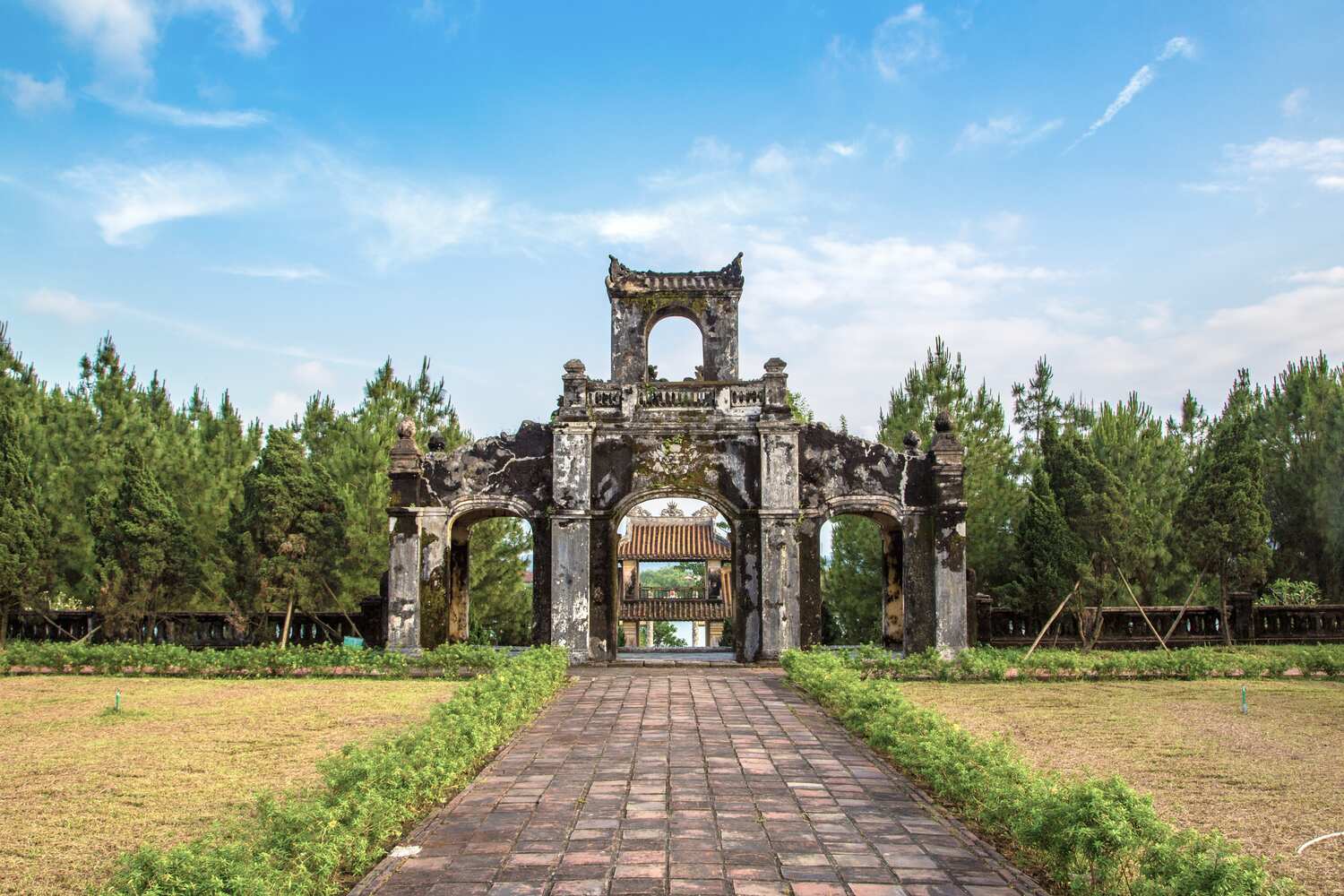
Tu Duc Tomb
Tu Duc Tomb, nestled in the outskirts of Hue, about 5 kilometers from the historic city center, stands as a testament to the life and legacy of Emperor Tu Duc, the fourth ruler of the Nguyen Dynasty. And it’s the first Royal Tomb you’ll see on this itinerary.
Designed by the emperor himself, this expansive complex served dual purposes: as a personal retreat during his reign from 1847 to 1883, and ultimately as his final resting place.
The site, known locally as Khiem Lang, reflects Tu Duc’s deep love for poetry, nature, and architecture. Spanning approximately 12 hectares, it features tranquil lotus ponds, ornate pavilions, and meandering pathways that invite visitors to explore its peaceful landscape.
The actual burial site of Tu Duc remains a mystery, hidden somewhere within the grounds, adding an air of intrigue to this historical haven.
Note that the complex is 20-hectare big, and it takes about 2 hours to visit, and that’s why I recommend coming after lunch, so you can digest your meal!
Just like the Citadel, it opens daily from 7.00 AM to 5.30 PM, so you have plenty of time to come.
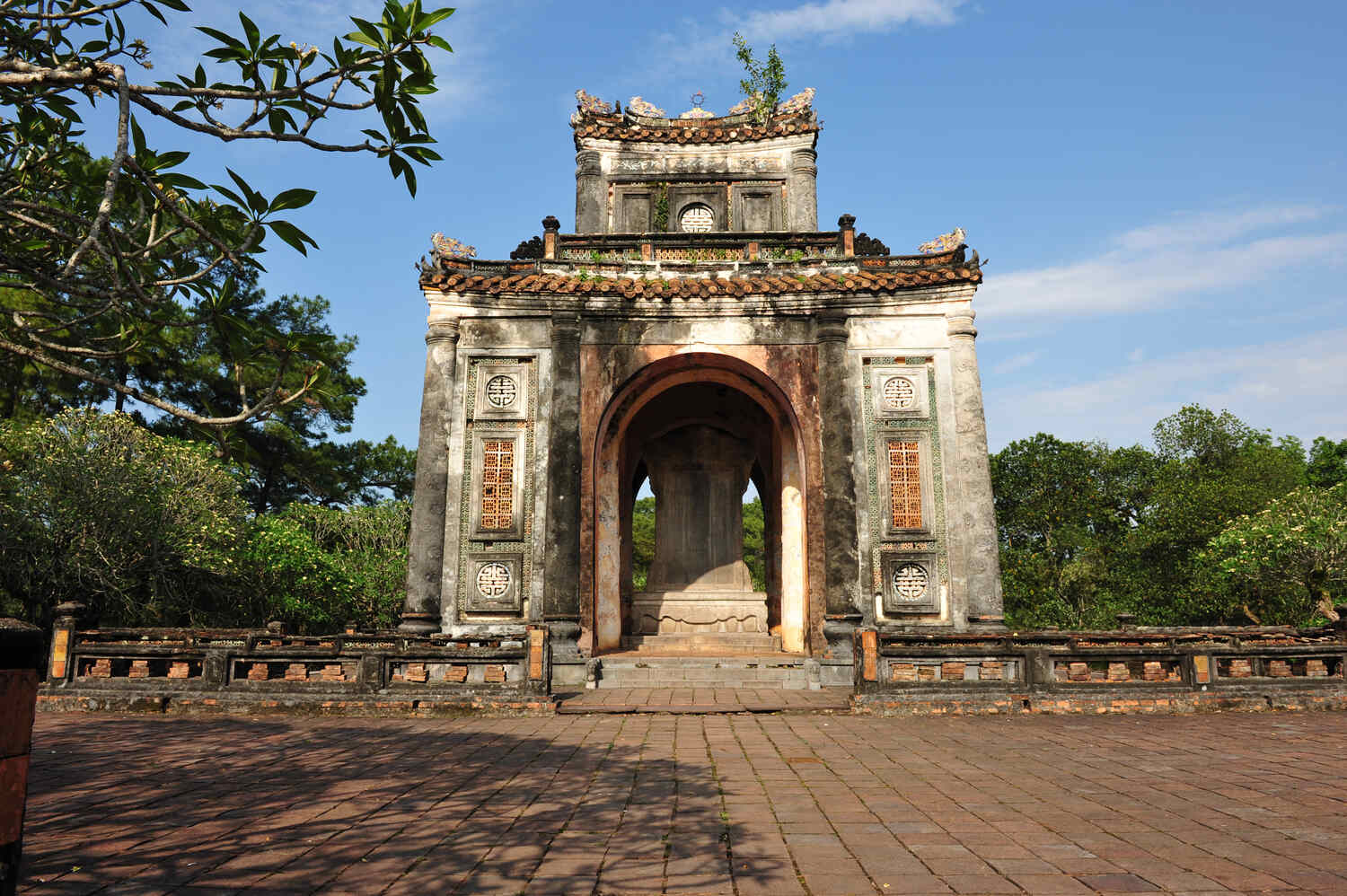
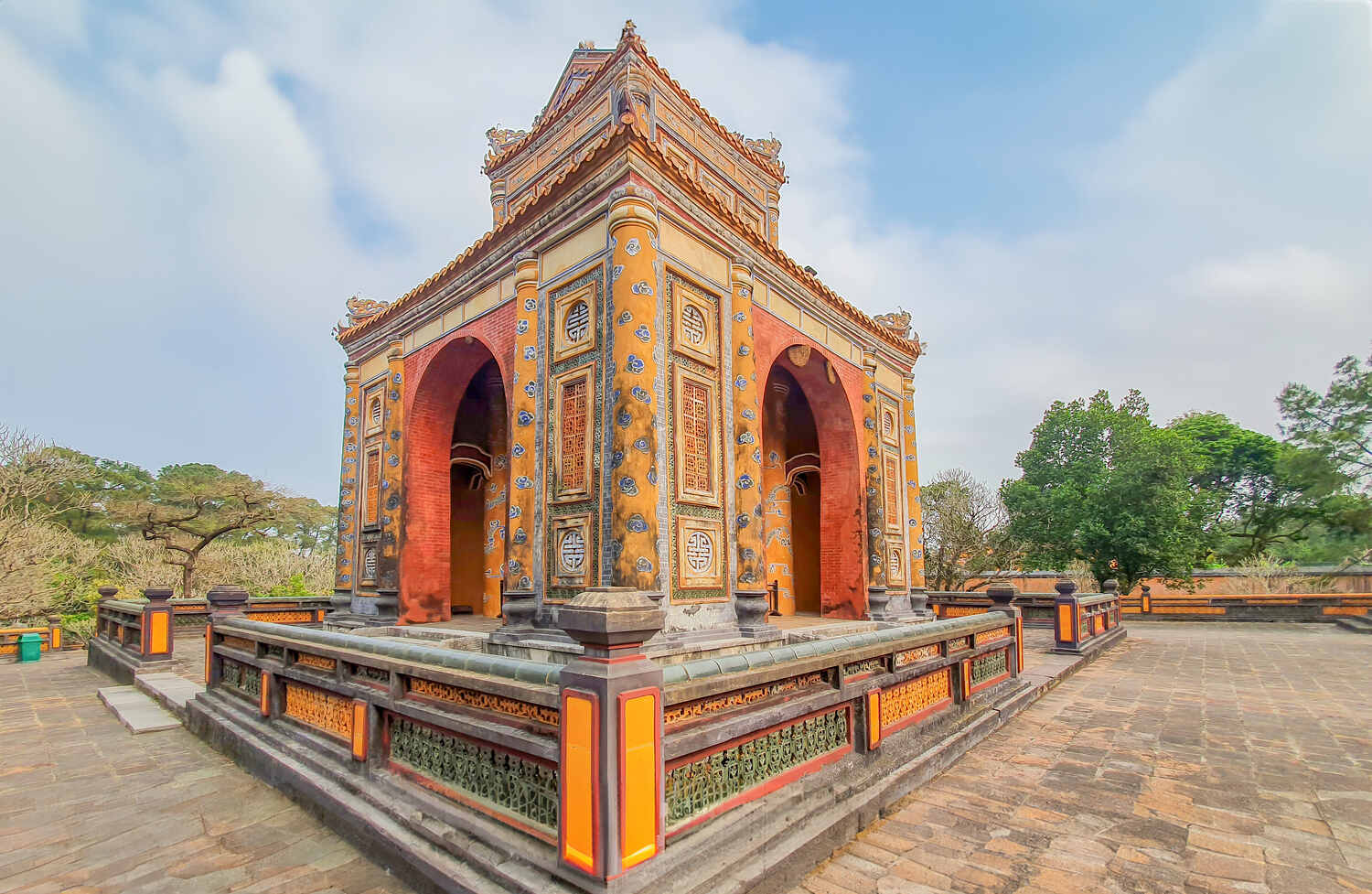
Travel Tips for a Hue Day Trip
Now that you know the best one-day in Hue itinerary for your trip, let’s answer some frequent questions from first-timers that may be helpful to you, too.
Is Hue Worth Visiting?
Absolutely! Hue is a hidden gem that is often overlooked for other destinations like Da Nang or Hoi An, but you’ll love it, no matter if you’re into history or want to try different foods.
You can explore the Imperial Citadel, learn about Vietnam’s royal past, and then treat your taste buds and eat Bun Bo Hue, a famous, delicious noodle soup.
Plus, the beautiful Perfume River adds a peaceful escape from the usual tourist hustle. It’s a perfect blend of culture, history, and natural beauty, which I personally loved.
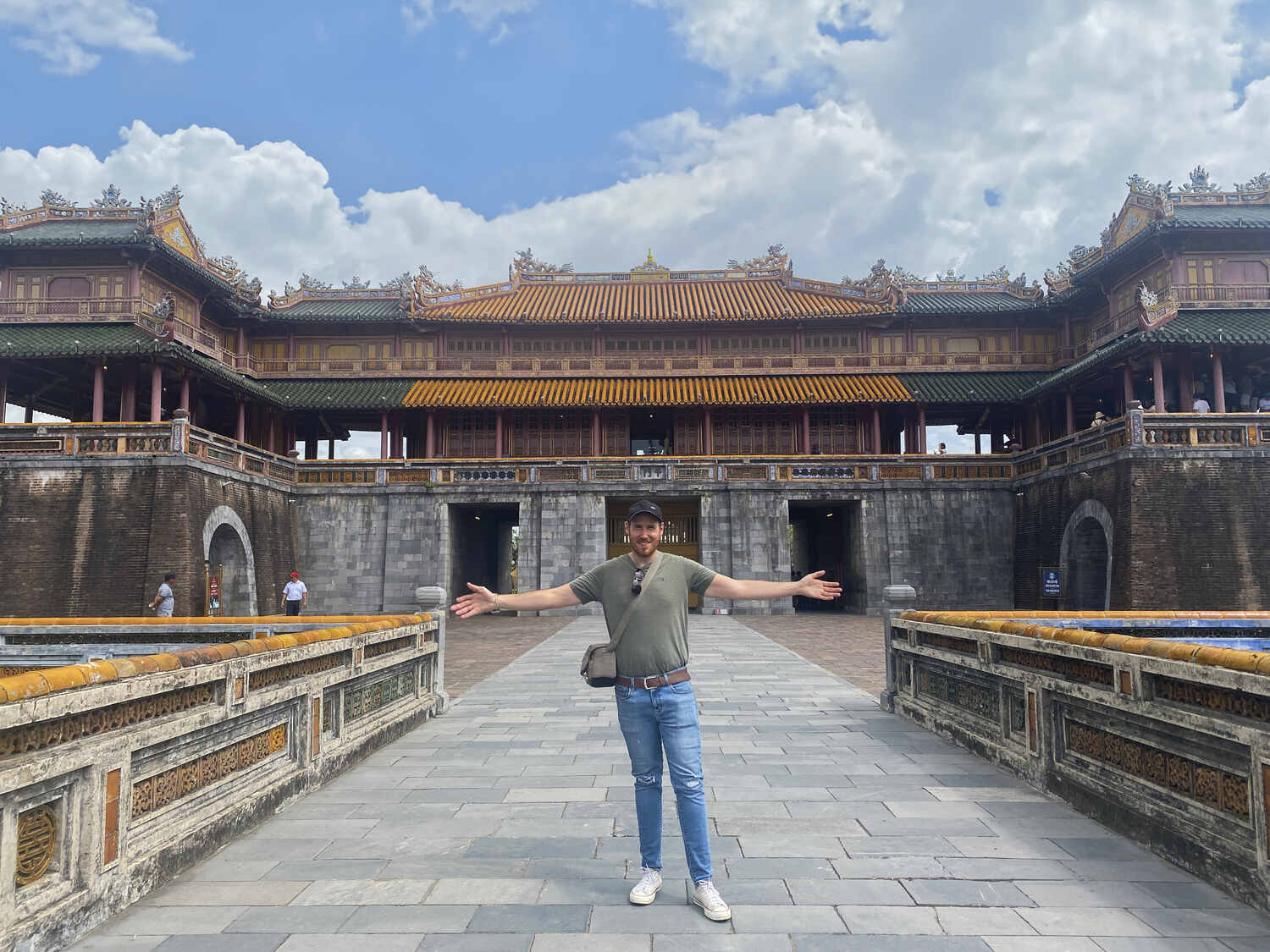
Best Time to Visit Hue
The best time to visit Hue is during the dry season, from January to August, when the weather is mild with less rainfall, making it ideal for sightseeing and outdoor activities.
February to April offers cooler temperatures and the vibrant Hue Festival, held every two years. Avoid September to December if possible, as this is the rainy season, which can lead to flooding and limit the things you can do on your trip.
Best Places to Eat in Hue
I mentioned a few places where to eat in Hue on this itinerary, but here are some more places to have a meal in town that are sure to please:
- Nook Eatery: Charming cafe with a relaxed atmosphere, famous for its Vietnamese coffee and Western breakfast options.
- Madam Thu Restaurant: Popular local eatery, best known for its spicy Bun Bo Hue and fresh spring rolls, in a cozy, authentic setting.
- Golden Rice Restaurant: Offers a memorable dining experience with standout dishes like Caramel Pork and Seafood Hot Pot in a comfortable, inviting ambiance.
- Les Jardins de la Carambole: Serves exquisite French-Vietnamese fusion cuisine, with highlights including Beef Bourguignon and Banh Khoai, set in a picturesque colonial garden.
- Cozy Restaurant Hue: Friendly spot offering a homey atmosphere with signature dishes like Grilled Lemongrass Pork and Hue Pancake, perfect for casual dining.
Best Food to Try in Hue
Hue’s culinary scene is rich with flavors. Here are six must-try dishes when you’re in Hue:
- Bun Bo Hue: A spicy beef noodle soup that’s considered the signature dish of Hue, characterized by its rich and flavorful broth.
- Banh Beo: Small, steamed rice cakes topped with shrimp, crispy pork skin, and served with a sweet fish sauce.
- Banh Khoai: A crispy pancake filled with shrimp, pork, bean sprouts, and served with a peanut dipping sauce.
- Nem Lui: Lemongrass skewers made with grilled pork, which are wrapped in rice paper with vegetables and dipped in a special sauce.
- Com Hen: A unique dish of rice topped with baby clams, pork cracklings, peanuts, and served with a clam broth.
- Banh Nam: Flat, steamed rice dumplings filled with shrimp and pork, wrapped in banana leaves, and steamed to perfection.
- Che Hue: A variety of traditional Vietnamese sweet soups and puddings, perfect for dessert, with flavors ranging from mung beans to tapioca and fruit.
Each dish offers a unique taste of Hue’s culinary traditions, making the city a food lover’s paradise.
Where to Stay in Hue
In case you choose to stay overnight in Hue, I recommend staying near the Imperial Citadel, which isn’t far from the main attractions, the night walking street, and bars and restaurants. Here are the best hotels in Hue to make the most of it.
Luxury: TTC Imperial Hotel
Just a short stroll from Truong Tien Bridge, TTC Imperial Hotel offers scenic views of the river with cozy, air-conditioned rooms, free high-speed WiFi, an outdoor pool, and multiple dining options including a bar with panoramic city vistas.
Close to major landmarks and with luxurious guestrooms overlooking key city sights, the hotel also boasts a fitness center, Royal Spa, and a casino club.

Mid-Range: White Lotus Hue Hotel
This 4-star hotel features an outdoor pool, restaurant, bar, and communal lounge, alongside free WiFi, room service, and a 24-hour front desk. Rooms are air-conditioned, equipped with modern amenities, and some include kitchens.
Facilities also include a sun terrace, concierge service, and tour desk.
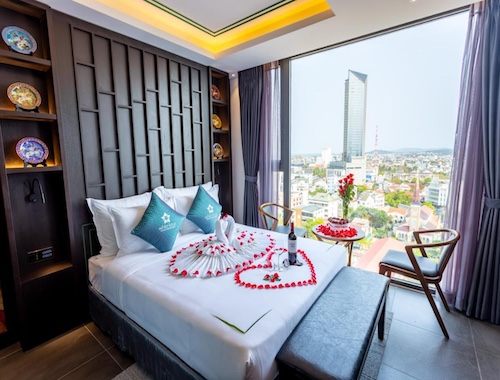
Budget: Hotel La Perle
Offering eco-friendly accommodations in the heart of Hue, Hotel La Perle utilizes solar energy and is close to the city center and Dong Ba Market.
The hotel provides free WiFi, in-house dining, and rooms with private bathrooms and air conditioning. Additional services include airport transfers, bike hire, and assistance with tours and tickets. I personally stayed here for a night and loved everything, plus, it was within walking distance to the Purple Forbidden City.

Conclusion – One Day Hue Itinerary
As the sun sets on your day trip to Hue, you’ll carry back more than just memories. You’ve walked through centuries in the Imperial Citadel, savored flavors that tell their own tales, and found peace along the river.
Hue isn’t just a stop on the map; it’s a journey through Vietnam’s heritage and culinary richness.
Thanks for reading until the end and I hope this guide was helpful to plan your trip!

